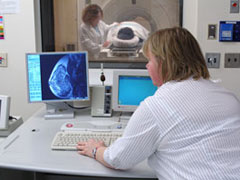Underestimating Overtreatment
By Laura Pratt
When a cancer is rare, it runs the risk of being misunderstood. Such appears to be the case with lobular carcinoma in situ (LCIS), a form of noninvasive breast cancer characterized by the presence of cancer cells in the lobules of the breast without invasion beyond those sites. Just 1% to 2% of breast cancers, and only 15% to 20% (in the United States) of all non-invasive cancers, are LCIS.
The spectrum of treatments in play for this disease is vast. Indeed, they range in invasiveness from mere observation, to tamoxifen, breast-conserving surgery alone, BCS followed by breast radiation, single mastectomies, right through to bilateral mastectomies. “The lack of knowledge and understanding around this is phenomenal,” says Dr. Eileen Rakovitch, a radiation oncologist and associate scientist at Sunnybrook Research Institute.
And that reality is particularly alarming considering that women diagnosed with LCIS have been shown to be at much higher risk (between 2.5 and five times) of developing an invasive breast cancer than the general population, in both the same and opposite breast. Statistics reveal a 4% possibility of getting invasive breast cancer for LCIS patients five years after diagnosis, and a 10% risk at 10 to 15 years beyond diagnosis.
However, doctors are unable to identify the women at highest risk for developing invasive cancer, because previous studies of LCIS included too few patients without complete evaluation of pathology.
“Are most women with LCIS being over- or under-treated?” asks Rakovitch. “We have no idea.”
That we don’t is the reason Rakovitch is leading a study—with a $585,000 research grant from the Canadian Breast Cancer Research Alliance in hand—to learn more about LCIS.
Specifically, Rakovitch and her team have launched a population-based analysis of LCIS to try to determine the best course of treatment for women diagnosed with this disease. To that end, they will assemble the largest cohort of LCIS patients ever—about 1,000 women diagnosed in Ontario over the last 10 years. This unprecedented assemblage is identifiable thanks to Ontario’s cancer registry, and the information gathered there is enhanced by that on offer from the Institute for Clinical Evaluative Sciences database, which details how these women were treated and what their outcomes were.
Having determined the current pattern of care and its results, Rakovitch and her fellow scientists—experts in pathology, all—will establish a systematic grading and scoring key that compares treatment to clinical outcomes.
Ideally, Rakovitch hopes her work will result in a better understanding of what low-risk and high-risk LCIS are, and an ability to direct treatment more effectively for those at risk, while minimizing over-treatment (including, principally, eliminating unnecessary mastectomies) for the majority of women with LCIS who will never die of breast cancer.
Rakovitch, who is also involved with another research grant, this one investigating ductal carcinoma in situ (DCIS), the most common form of noninvasive breast cancer, says the most exciting part of her research is the promise it offers to “better target those women who are at risk, and to save a lot of unnecessary morbidity.”
PDF / View full media release »





